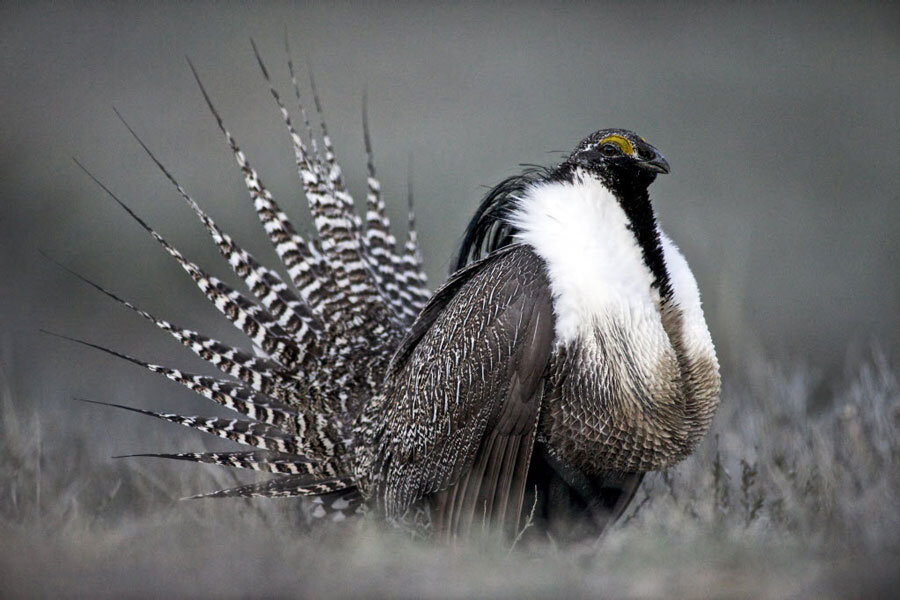Why did Colorado governor oppose threatened listing of Gunnison sage grouse?
| Boulder, Colo.
Federal wildlife officials announced Wednesday that the Gunnison sage grouse, a grassland bird whose numbers have been reduced to fewer than 5,000 by development, will be afforded "threatened" status under the Endangered Species Act.
The decision was a blow to Colorado leaders, including Gov. John Hickenlooper, who had pushed for the court-ordered decision to be delayed again to allow for further voluntary measures to protect the grouse. Governor Hickenlooper has said Colorado would sue if the US Fish and Wildlife Service went ahead with either a "threatened" or "endangered" listing.
And the decision by the US Fish and Wildlife Service (FWS) to go with the less restrictive "threatened" listing – a compromise of sorts – was also criticized by WildEarth Guardians, the group that has pushed hardest for the bird to be listed as endangered.
"While many people hoped that the extraordinary conservation efforts by our partners in Colorado and Utah would resolve all the threats faced by the Gunnison sage grouse, the best available science indicates that the species still requires the Act's protection," said US Fish and Wildlife Director Dan Ashe in a statement. "This is a work in progress, however, and we will continue to join our partners in protecting and restoring the rangelands with the hope that, in the near future, the Gunnison sage grouse will no longer need additional protection."
The Gunnison sage grouse – a separate species from the more abundant western sage grouse, which lives in 11 states – is considered an indicator species and is known for its elaborate courtship dance in the spring. The approximately 4,750 birds who remain live in eastern Utah and western Colorado on between 7 and 12 percent of their historic habitat. About 80 percent of those birds live in the Gunnison Basin in Colorado.
FWS has been considering a listing since 2010, but a decision has been delayed several times, as local groups have worked to prove that they can stabilize the grouse population successfully through voluntary efforts, while avoiding the sometimes onerous listing restrictions.
In Gunnison County, a coalition of landowners, government leaders, environmental groups, and the energy industry have implemented major efforts to preserve grouse habitat and stabilize the population. Private landowners close roads during the nesting season between March and May and a county biologist screens all homes, roads, and new development to ensure they don't harm the grouse.
In making the listing, FWS noted that those efforts have paid off, and the Gunnison Basin population is now stable. But several smaller satellite populations in southern Colorado and southeast Utah, ranging in size from 16 to 200 birds, are declining, the agency said. It is designating 1.4 million acres as critical habitat necessary for the species's survival and recovery.
"We believe the best science available points to the conclusion that the bird, while not facing extinction ... is still likely to face extinction in the future," said Mr. Ashe said in a call with reporters.
Some advocates for the grouse have worried that a listing would harm the conservation efforts already in place, and cause landowners, farmers, or oil and natural gas companies who were hoping to stave off a listing to stop those voluntary efforts.
FWS said that those efforts were largely responsible for its decision to go with the "threatened," rather than "endangered" status, however, and noted that such status will give much more flexibility to landowners.
In early 2015, it plans to propose a special rule that will allow ranchers, farmers, and other landowners who commit to conservation efforts for the grouse to continue to manage their land without more restrictions. It's unclear exactly how the listing decision will affect oil and gas development in the area, though Ashe said particular attention will be given to how any development affects the areas where the grouse gather for their mating rituals.
And if some were disappointed that the listing decision wasn't delayed, others thought the decision didn't go far enough.
The fewer than 5,000 remaining Gunnison sage grouse need the strongest possible protections to ensure they survive and recover,” said Erik Molvar, wildlife biologist with WildEarth Guardians, in a statement. “The science is clear, this spectacular dancing bird is endangered and should be afforded the highest level of protection.”






